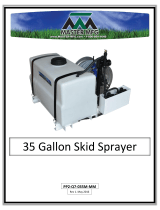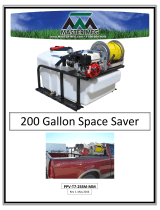
Summary of Important Safety Information
5
Read and understand this owner's manual completely before using the sprayer. Read each chemical
label's instructions before handling the chemical.
Improper use of the sprayer or handling of chemicals could result in serious injury or illness for the
operator or nearby persons/animals, or cause damage to the environment.
LISTED BELOW is a summary of safety information of particular importance. See individual sections of
this owner's manual for more details.
-------------------------------------- DURING ASSEMBLY --------------------------------------
EXERCISE CAUTION when attaching remote switch to battery terminals. Follow the steps listed in the Assembly
section of this manual in exact sequence when connecting the sprayer's remote switch battery clamps to the battery
terminals. Caution must be exercised to avoid contact with battery acid and to prevent sparking.
CHECK and TEST completed assembly as directed in this manual. Serious injury could result from chemical leaks if
sprayer is improperly assembled.
DO NOT MODIFY sprayer design.
------------------------------------- DURING OPERATION -------------------------------------
General Chemical Safety
READ and FOLLOW each chemical label's instructions and warnings.
AVOID inhaling, ingesting, or coming into contact with any chemicals.
KNOW applicable licensing and regulatory requirements for the chemical you plan to use.
KNOW emergency procedures before handling chemicals. Carefully review "Chemical Accident Procedures" listed
below and later in this manual. Also see First Aid instructions on the chemical label.
WEAR protective clothing, eye protection, and chemical resistant gloves when filling, using and cleaning the sprayer.
Wear additional protective gear, such as facemask or apron, as recommended on the chemical label.
EXERCISE EXTRA CAUTION around children and pets. Pesticides are especially toxic to them. Keep sprayer and
spray materials away from them at all times.
DO NOT MIX OR POUR chemicals in an enclosed, unventilated area
DO NOT USE flammable or corrosive chemicals in the sprayer.
FLUSH the sprayer before switching chemicals in order to prevent dangerous chemical interactions.
STORE pesticides in a correctly labeled container and in a secure location.
MONITOR the health of operators frequently exposed to pesticides, as recommended by the chemical label or
local/federal regulations.
Chemical Application Safety
Before Spraying
INSPECT and PREPARE sprayer before each use as directed in this manual.
DO NOT TURN ON POWER to sprayer until ready to spray in order to avoid unintentional spray release.
MAKE SURE BROADCAST NOZZLES ARE ORIENTED to spray straight down before starting the sprayer. An
incorrectly positioned broadcast nozzle may spray chemicals on you or others.
DO NOT SPRAY when wind speed exceeds 4 MPH in order to minimize spray drift.
CLEAR work area of people/ pets and POST warning notices to restrict access for the period recommended on chemical
label.
KEEP sprayer and spray away from children/pets. Pesticides can be especially toxic to children and animals.
DO NOT ALLOW anyone younger than 16 to operate sprayer since pesticides are especially toxic to children.
During Spraying
DO NOT OVERAPPLY pesticide. Apply at rate recommended by chemical manufacturer. Excess pesticide can be
dangerous to humans/animals, damage desirable plants, and contaminate soil and water sources.
DO NOT EAT, DRINK, SMOKE, RUB YOUR EYES, or TOUCH YOUR BARE SKIN while handling chemicals
and spraying.
NEVER POINT THE SPRAY GUN at people or animals.
EXERCISE EXTRA CAUTION when spraying near areas accessible to children and pets.
CLEAN up spills immediately per instructions on the chemical label.
TURN OFF vehicle and set brake or block wheels, TURN OFF power to sprayer, and RELIEVE system pressure
before leaving sprayer unattended.





















